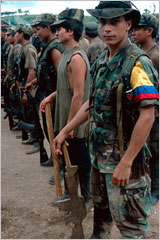|
La
violencia
Historians trace the violence of today back to a period spanning
the late 1940s and 1950s known simply as "La Violencia"
-- or "The Violence"--a civil war between supporters of
the traditional Liberal and Conservative Parties that have alternately
held power in Colombia for the last 150 years.
The trigger for the fighting was the assassination of populist Liberal
Party leader politician Jorge Eliecer Gaitán on April 9,
1948. The killing, which has been blamed on rival Liberal factions,
on the Conservatives, on a lone gunman, and even on the CIA, sparked
rioting in Bogotá, but the main focus of fighting rapidly
spread to the countryside.
The Conservative Party activated its powerful allies within the
military, police, and the Catholic church; the Liberals rapidly
organized guerrilla groups comprised mainly of peasants and workers.
While leaders from both parties remained safely entrenched in the
cities, their poor supporters did battle in the countryside, against
a backdrop of massacres, rapes, and murders.
In 1957, a series of amnesties for the guerrillas and the advent
of a power-sharing deal, known as the National Front, between Conservative
and Liberal leaders put a temporary end to the bloodshed. The arrangement,
which lasted 16 years, brought some political stability and moderate
economic growth, but still left the running of the country to the
political and economic elites who had little interest in sharing
decisions—let alone wealth--with the underclasses.
The guerrillas consolidate
Since its establishment in 1964, the FARC has been under the command
of its founder, Manuel "Sureshot" Marulando, a former
Liberal guerrilla whose political and social model was the Soviet
Union. Tirofijo [his nickname in Spanish] and his original
48 founding peasants first mobilized at the height of a U.S.-backed
offensive dubbed "Operation Lasso", designed to wipe out
what the government termed "independent republics," or
regions loyal to the Communist Party.
In the same year, Fabio Vásquez Castaño, the well-educated
son of a Liberal family who lost his father at the hands of Conservative
vigilantes, formed the ELN in oil-rich northeast Colombia. Many
of the peasants that joined ELN ranks had been displaced by private
national and international oil companies arriving in the area. Other
early members were unionized oil workers from Barrancabermeja. Unlike
the FARC, the ELN drew its inspiration from the Cuban Revolution
rather than adhering to the strict Soviet line of the Colombian
Communist Party.
The ELN quickly attracted the support of firebrand Roman Catholic
priests, who ushered in grassroots and student groups, unions, and
some urban intellectuals, helping the ELN to extend its influence
far beyond its military reach. A defrocked Spanish priest known
as Manuel Pérez headed the rebel force until his death in
early 1998.
|

San
Vicente del Caguán, Colombia Members of the FARC, Latin America's
oldest and largest guerrilla army.
|
